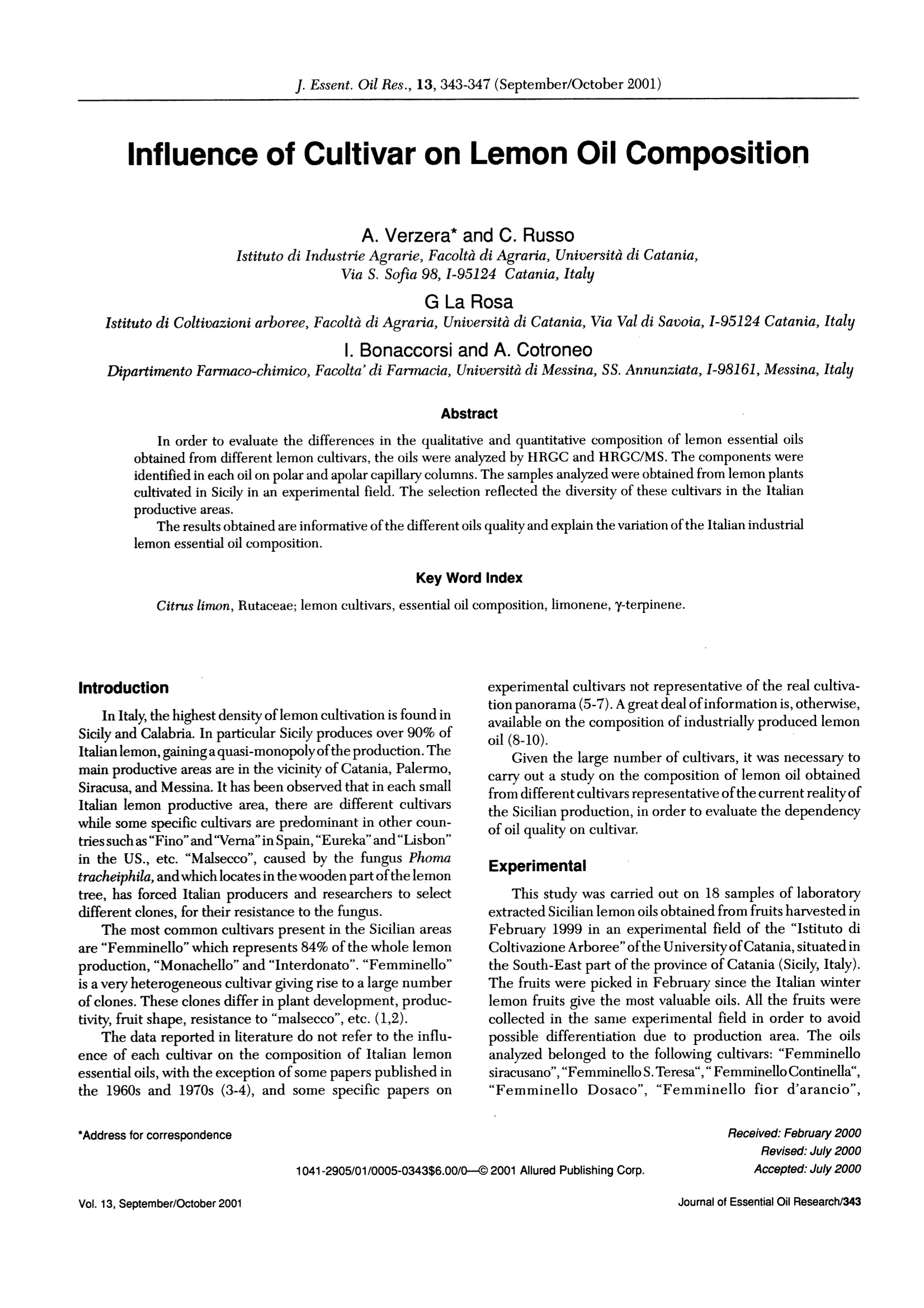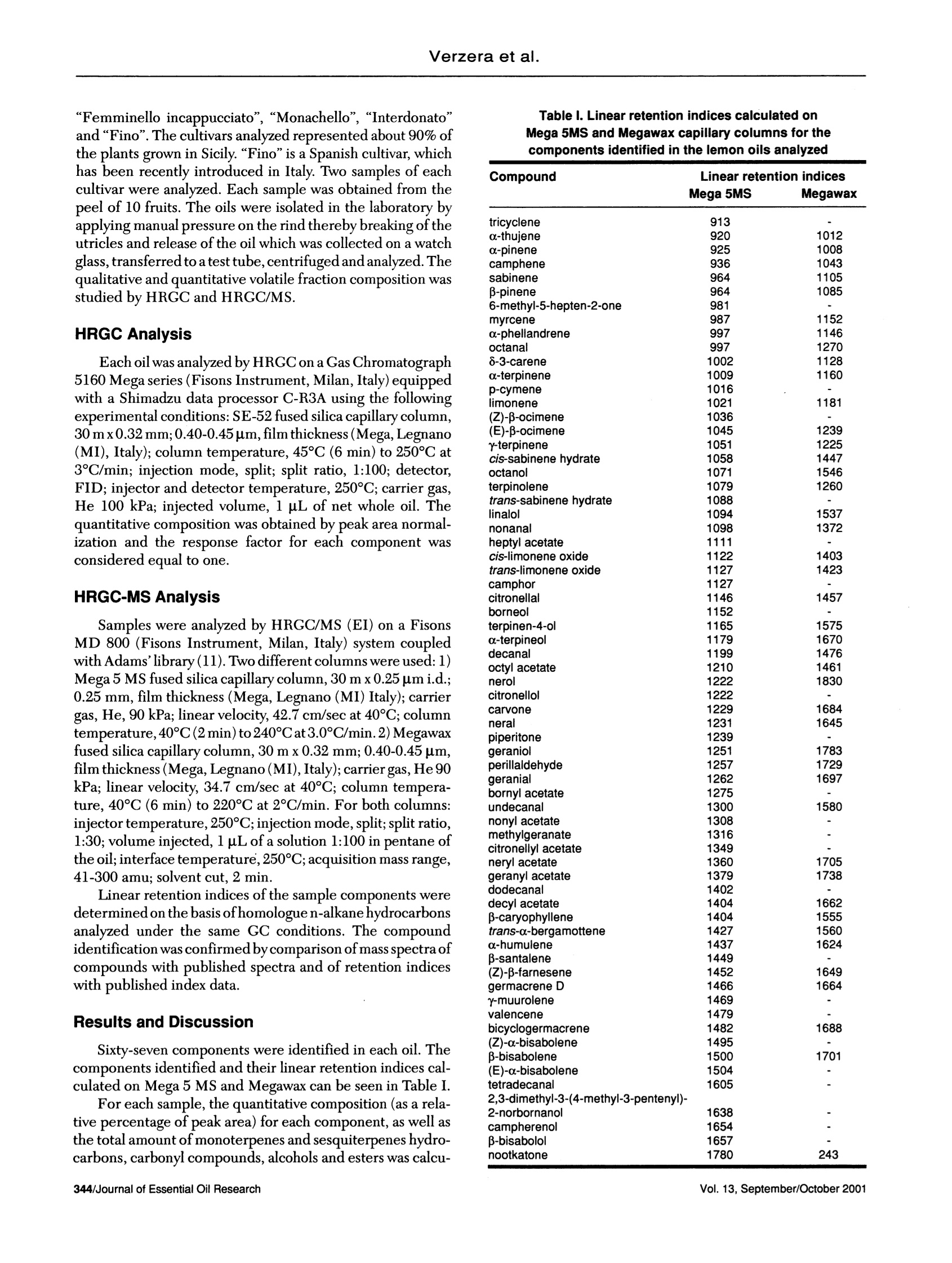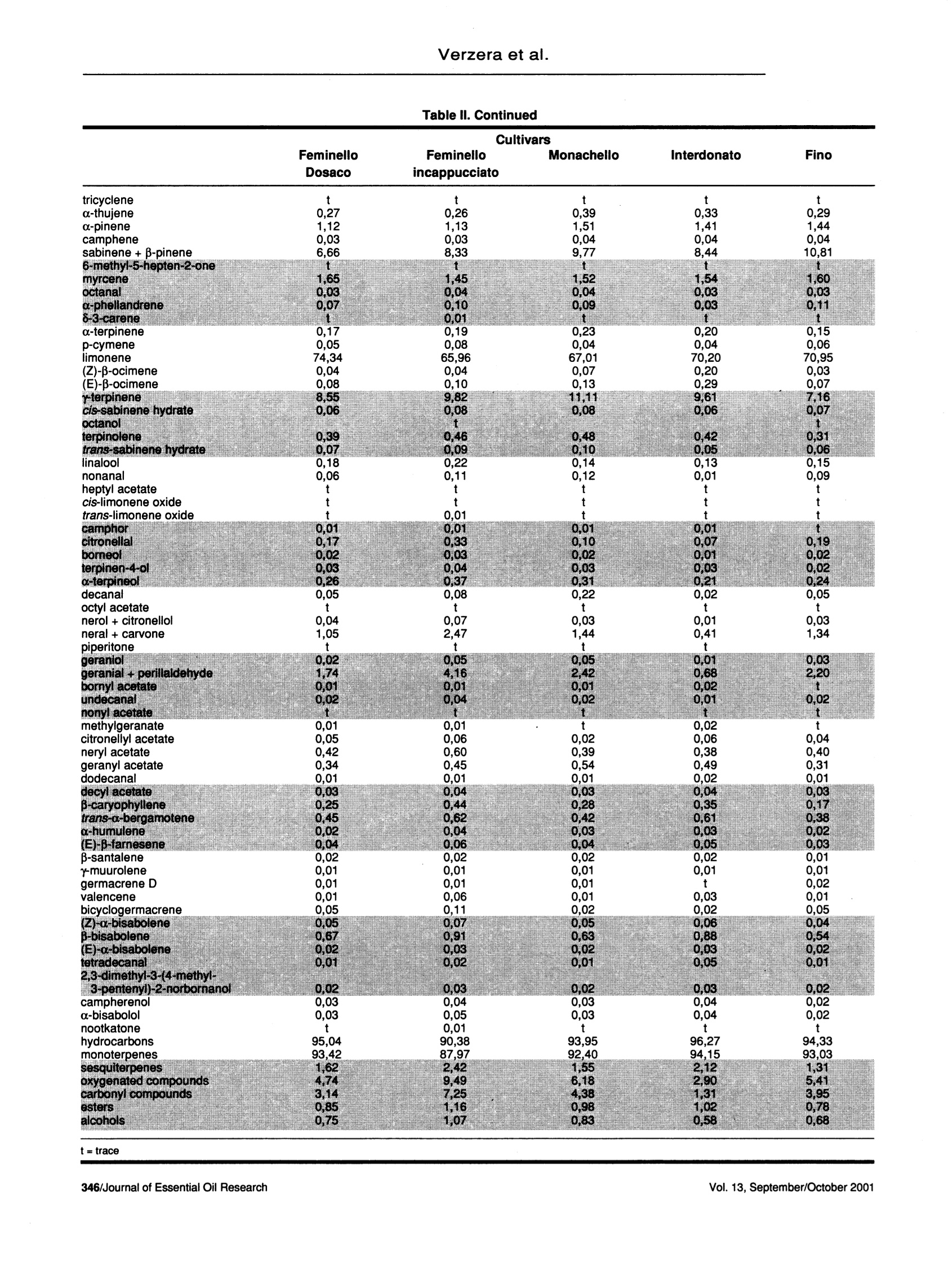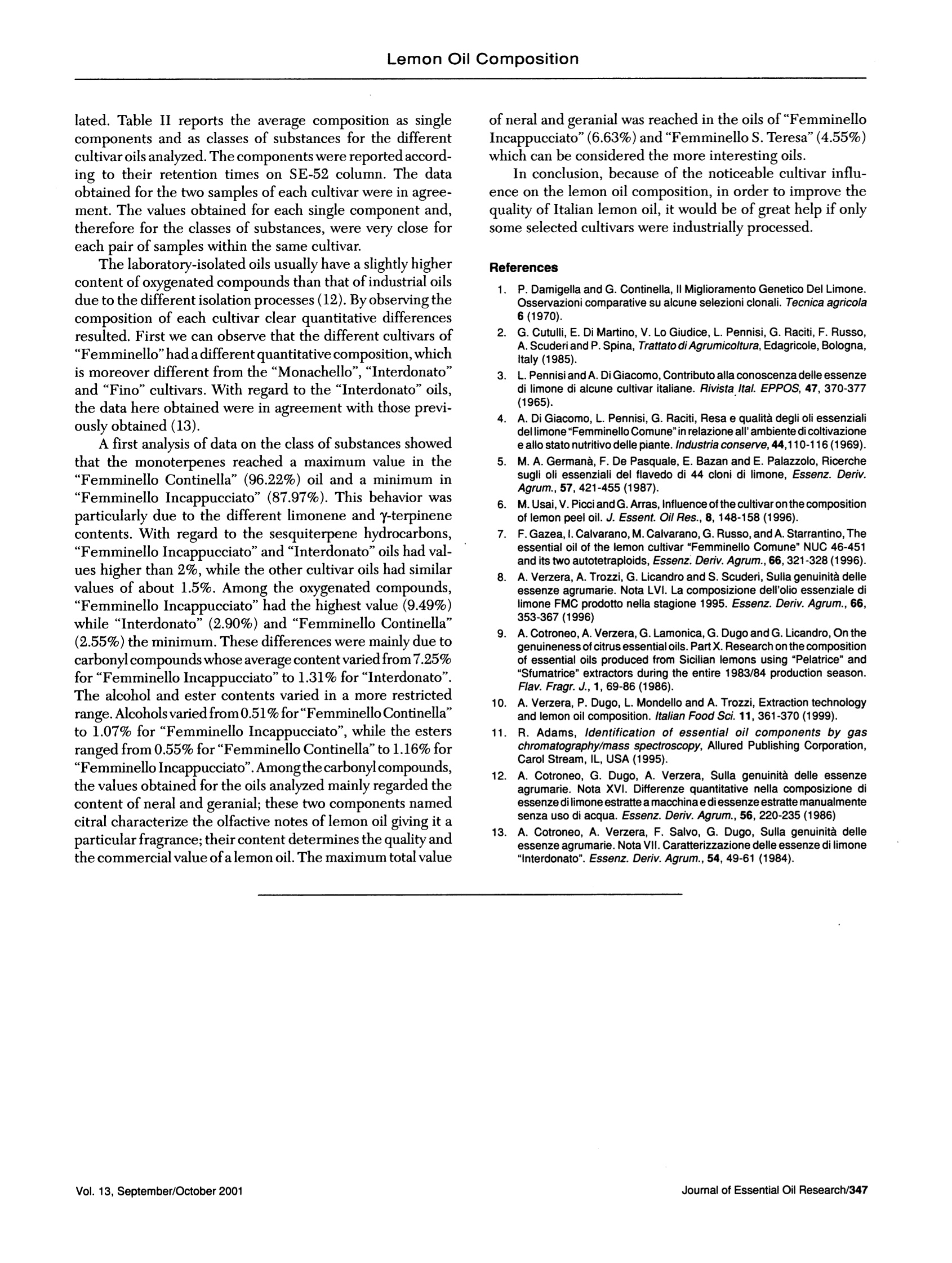
in italy,the highest density of lemon cultivation is ....
方案详情

J. Essent. Oil Res., 13, 343-347 (September/October 2001) Verzera et al. Influence of Cultivar on Lemon Oil Composition A. Verzera* and C. Russo Istituto di Industrie Agrarie, Facolta di Agraria, Universita di Catania, Via S. Sofia 98, I-95124 Catania, Italy G La Rosa Istituto di Coltivazioni arboree, Facolta di Agraria, Universita di Catania, Via Val di Savoia, I-95124 Catania, Italy l. Bonaccorsi and A. Cotroneo Dipartimento Farmaco-chimico, Facolta’ di Farmacia, Universita di Messina, SS. Annunziata, I-98161, Messina, Italy Abstract In order to evaluate the differences in the qualitative and quantitative composition of lemon essential oilsobtained from different lemon cultivars, the oils were analyzed by HRGC and HRGC/MS. The components wereidentified in each oil on polar and apolar capillary columns. The samples analyzed were obtained from lemon plantscultivated in Sicily in an experimental field. The selection reflected the diversity of these cultivars in the Italianproductive areas. The results obtained are informative of the different oils quality and explain the variation ofthe Italian industriallemon essential oil composition.1. Key Word Index Citrus limon, Rutaceae;lemon cultivars, essential oil composition, limonene, y-terpinene. Introduction In Italy, the highest density of lemon cultivation is found inSicily and Calabria. In particular Sicily produces over 90% ofItalian lemon,gaininga quasi-monopoly ofthe production. Themain productive areas are in the vicinity of Catania, Palermo,Siracusa, and Messina. It has been observed that in each smallItalian lemon productive area, there are different cultivarswhile some specific cultivars are predominant in other coun-tries such as"Fino"and"Verna”in Spain,"Eureka”and"Lisbon"in the US., etc. “Malsecco”, caused by the fungus Phomatracheiphila,andwhich locates in the wooden part ofthe lemontree, has forced Italian producers and researchers to selectdifferent clones, for their resistance to the fungus. The most common cultivars present in the Sicilian areasare“Femminello”which represents 84% of the whole lemonproduction,“Monachello”and“Interdonato”.“Femminello"is a very heterogeneous cultivar giving rise to a large numberof clones. These clones differ in plant development, produc-tivity, fruit shape, resistance to“malsecco", etc. (1,2). The data reported in literature do not refer to the influ-ence of each cultivar on the composition of Italian lemonessential oils, with the exception of some papers published inthe 1960s and 1970s (3-4), and some specific papers on experimental cultivars not representative of the real cultiva-tion panorama(5-7). A great deal of information is, otherwise,available on the composition of industrially produced lemonoil (8-10). Given the large number of cultivars, it was necessary tocarry out a study on the composition of lemon oil obtainedfrom different cultivars representative ofthe current reality ofthe Sicilian production, in order to evaluate the dependencyof oil quality on cultivar. Experimental This study was carried out on 18 samples of laboratoryextracted Sicilian lemon oils obtained from fruits harvested inFebruary 1999 in an experimental field of the “Istituto diColtivazione Arboree"ofthe University of Catania, situated inthe South-East part of the province of Catania (Sicily, Italy).The fruits were picked in February since the Italian winterlemon fruits give the most valuable oils. All the fruits werecollected in the same experimental field in order to avoidpossible differentiation due to production area. The oilsanalyzed belonged to the following cultivars: “Femminellosiracusano"“Femminello S.Teresa",“FemminelloContinella","Femminello Dosaco”,“Femminello fior d'arancio", Accepted: July 2000 "Femminello incappucciato”,“Monachello”,“Interdonato”and“Fino".The cultivars analyzed represented about 90% ofthe plants grown in Sicily. “Fino” is a Spanish cultivar, whichhas been recently introduced in Italy. Two samples of eachcultivar were analyzed. Each sample was obtained from thepeel of 10 fruits. The oils were isolated in the laboratory byapplying manual pressure on the rind thereby breaking of theutricles and release of the oil which was collected on a watchglass,transferred to a test tube,centrifuged and analyzed. Thequalitative and quantitative volatile fraction composition wasstudied by HRGC and HRGC/MS. HRGC Analysis Each oil was analyzed by HRGC on a Gas Chromatograph5160 Mega series (Fisons Instrument, Milan, Italy) equippedwith a Shimadzu data processor C-R3A using the followingexperimental conditions: SE-52 fused silica capillary column,30 m x0.32 mm; 0.40-0.45 pm, film thickness (Mega, Legnano(MI), Italy); column temperature, 45°C (6 min) to 250°℃ at3°C/min; injection mode, split; split ratio, 1:100; detector,FID; injector and detector temperature, 250℃; carrier gas,He 100 kPa; injected volume, 1 pL ofnet whole oil. Thequantitative composition was obtained by peak area normal-ization and the response factor for each component wasconsidered equal to one. HRGC-MS Analysis Samples were analyzed by HRGC/MS (EI) on a FisonsMD 800 (Fisons Instrument, Milan, Italy) system coupledwith Adams'library(11). Two different columns were used: 1)Mega 5 MS fused silica capillary column, 30 m x0.25 um i.d.;0.25 mm, film thickness (Mega, Legnano (MI) Italy); carriergas, He, 90 kPa; linear velocity, 42.7 cm/sec at 40°℃; columntemperature,40℃(2 min)to240°Cat 3.0°C/min.2)Megawaxfused silica capillary column, 30 m x0.32 mm; 0.40-0.45 pm,film thickness(Mega, Legnano(MI),Italy); carrier gas, He 90kPa; linear velocity, 34.7 cm/sec at 40°C; column tempera-ture, 40°℃ (6 min) to 220℃ at 2°C/min. For both columns:injector temperature, 250℃; injection mode, split; split ratio,1:30; volume injected, 1 uL of a solution 1:100 in pentane ofthe oil; interface temperature, 250C;acquisition mass range,41-300 amu; solvent cut, 2 min. Linear retention indices of the sample components weredetermined on the basis ofhomologue n-alkane hydrocarbonsanalyzed under the same GC conditions. The compoundidentification was confirmed by comparison of mass spectra ofcompounds with published spectra and of retention indiceswith published index data. Results and Discussion Sixty-seven components were identified in each oil. Thecomponents identified and their linear retention indices cal-culated on Mega 5 MS and Megawax can be seen in Table I. For each sample, the quantitative composition (as a rela-tive percentage of peak area) for each component, as well asthe total amount of monoterpenes and sesquiterpenes hydro-carbons, carbonyl compounds, alcohols and esters was calcu- Table l. Linear retention indices calculated onMega 5MS and Megawax capillary columns for the Table Il. Percentage composition (mean values X with standard deviations s) as single compounds and asclasses of substances for the different lemon cultivar oils analyzed Table Il. Continued t = trace lated. Table II reports the average composition as singlecomponents and as classes of substances for the differentcultivar oils analyzed. The components were reported accord-ing to their retention times on SE-52 column. The dataobtained for the two samples of each cultivar were in agree-ment. The values obtained for each single component and,therefore for the classes of substances, were very close foreach pair of samples within the same cultivar. The laboratory-isolated oils usually have a slightly highercontent of oxygenated compounds than that of industrial oilsdue to the different isolation processes (12). By observing thecomposition of each cultivar clear quantitative differencesresulted. First we can observe that the different cultivars of"Femminello"had a different quantitative composition, whichis moreover different from the“Monachello”,“Interdonato”and “Fino”cultivars.With regard to the “Interdonato”oils,the data here obtained were in agreement with those previ-ously obtained (13). A first analysis of data on the class of substances showedthat the monoterpenes reached a maximum value in the“Femminello Continella”(96.22%) oil and a minimum in"Femminello Incappucciato”(87.97%). This behavior wasparticularly due to the different limonene and y-terpinenecontents. With regard to the sesquiterpene hydrocarbons,“Femminello Incappucciato"and "Interdonato"oils had val-ues higher than 2%, while the other cultivar oils had similarvalues of about 1.5%. Among the oxygenated compounds,"Femminello Incappucciato"had the highest value (9.49%)while “Interdonato”(2.90%) and“Femminello Continella”(2.55%) the minimum. These differences were mainly due tocarbonyl compounds whose average content varied from 7.25%for "Femminello Incappucciato”to 1.31% for "Interdonato”.The alcohol and ester contents varied in a more restrictedrange. Alcohols varied from0.51% for“Femminello Continella"to 1.07% for“Femminello Incappucciato”, while the estersranged from 0.55% for“Femminello Continella”to 1.16% for"Femminello Incappucciato". Among the carbonylcompounds,the values obtained for the oils analyzed mainly regarded thecontent of neral and geranial; these two components namedcitral characterize the olfactive notes of lemon oil giving it aPparticular fragrance; their content determines the quality andthe commercial value of alemon oil. The maximum total value of neral and geranial was reached in the oils of"FemminelloIncappucciato”(6.63%) and"Femminello S. Teresa”(4.55%)which can be considered the more interesting oils. In conclusion, because of the noticeable cultivar influ-ence on the lemon oil composition, in order to improve thequality of Italian lemon oil, it would be of great help if onlysome selected cultivars were industrially processed. References 1.P. Damigella and G. Continella, II Miglioramento Genetico Del Limone.Osservazioni comparative su alcune selezioni clonali. Tecnica agricola6 (1970). 2.G. Cutulli, E. Di Martino, V. Lo Giudice, L. Pennisi, G. Raciti, F. Russo,A. Scuderiand P. Spina, Trattato di Agrumicoltura, Edagricole, Bologna,Italy (1985). 3 L. Pennisi and A. Di Giacomo, Contributo alla conoscenza delle essenzedi limone di alcune cultivar italiane. Rivista Ital. EPPOS,47, 370-377(1965). 4. A. Di Giacomo, L. Pennisi, G. Raciti, Resa e qualita deglioli essenzialidel limone"Femminello Comune"in relazione all' ambiente dicoltivazioneeallo stato nutritivo delle piante.Industria conserve, 44,110-116(1969). 5 M. A. Germana, F. De Pasquale, E. Bazan and E. Palazzolo, Ricerchesugli oli essenziali del flavedo di 44 cloni di limone, Essenz. Deriv.Agrum., 57,421-455 (1987). 6.M.Usai,V. PicciandG. Arras, Influenceof the cultivar on the compositionof lemon peel oil. J. Essent. Oil Res., 8, 148-158 (1996). 7.F. Gazea,I. Calvarano,M.Calvarano,G.Russo,and A. Starrantino,Theessential oil of the lemon cultivar“Femminello Comune"NUC 46-451and its two autotetraploids, Essenz. Deriv. Agrum., 66,321-328(1996). .8. A. Verzera, A. Trozzi, G. Licandro and S. Scuderi, Sulla genuinita delleessenze agrumarie. Nota LVI. La composizione dell'olio essenziale dilimone FMC prodotto nella stagione 1995. Essenz. Deriv.Agrum., 66,353-367(1996) 9. A. Cotroneo,A. Verzera,G. Lamonica,G. Dugo and G. Licandro,On thegenuineness of citrus essential oils. Part X. Research on the compositionof essential oils produced from Sicilian lemons using “Pelatrice” and“Sfumatrice” extractors during the entire 1983/84 production season.Flav. Fragr.J., 1, 69-86(1986). 10..A. Verzera, P. Dugo, L. Mondello and A. Trozzi, Extraction technologyand lemon oil composition. Italian Food Sci. 11, 361-370(1999). 11.1.R. Adams, Identification of essential oil components by gaschromatography/mass spectroscopy, Allured Publishing Corporation,Carol Stream, IL,USA (1995). 12.A. Cotroneo, G. Dugo, A. Verzera, Sulla genuinita delle essenzegemagrumarie. Nota XVI. Differenze quantitative nella composizione diessenze di limone estratte a macchinaediessenze estratte manualmentesenza uso di acqua. Essenz. Deriv. Agrum., 56, 220-235(1986) 13.A. Cotroneo, A. Verzera, F. Salvo, G. Dugo, Sulla genuinita delleessenze agrumarie. Nota VII.Caratterizzazione delle essenze di limone“Interdonato". Essenz. Deriv. Agrum., 54, 49-61(1984). Received: February Address for correspondenceRevised: July CAllured Publishing Corp.Journal of Essential Oil Research/ol. September/October Journal of Essential Oil ResearchVol. September/October
确定





还剩3页未读,是否继续阅读?
华明科技(香港)有限公司为您提供《柠檬油中成分分析检测方案 》,该方案主要用于日用化学品/香精香料中成分分析检测,参考标准--,《柠檬油中成分分析检测方案 》用到的仪器有
相关方案
更多







